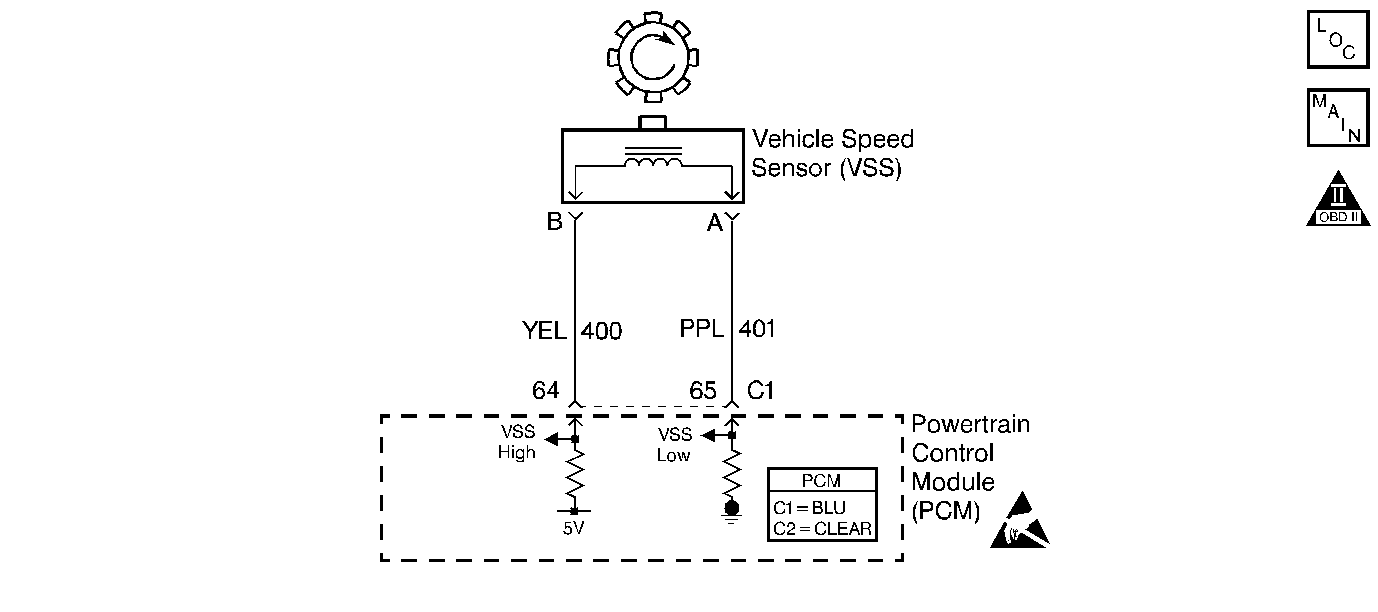
Circuit Description
Vehicle speed information is provided to the PCM by the Vehicle Speed Sensor (VSS). The VSS consists of a magnetic pickup sensor mounted to the transmission case which interfaces with a rotor pressed onto to the transmission output shaft. The VSS produces a frequency signal that is proportional to vehicle speed. The PCM converts the VSS signal to vehicle speed, displayed on the scan tool in miles per hour and kilometers per hour. The PCM also uses the VSS signal to generate the 4000 pulses per mile vehicle speed signal used by the instrument cluster and the stepper motor cruise control module.
Conditions for Running the DTC
| • | Engine speed is greater than 1000 RPM. |
| • | Engine load and engine speed acceleration indicate that the vehicle is in gear. |
Conditions for Setting the DTC
Vehicle speed sensor indicates a speed of less than 5 km/h (3 MPH) for greater than 20 seconds.
Action Taken When the DTC Sets
| • | The PCM will illuminate the malfunction indicator lamp (MIL) during the second consecutive trip in which the diagnostic test has been run and failed. |
| • | The PCM will store conditions which were present when the DTC set as Freeze Frame and Failure Records data. |
Conditions for Clearing the MIL/DTC
| • | The PCM will turn OFF the MIL during the third consecutive trip in which the diagnostic has been run and passed. |
| • | The History DTC will clear after 40 consecutive warm-up cycles have occurred without a malfunction. |
| • | The DTC can be cleared by using the scan tool. |
Diagnostic Aids
The scan tool should display vehicle speed while the drive wheels are turning. If you suspect that an intermittent fault exists, check for the following conditions:
Poor connection at the PCM or the VSS - Inspect harness connectors for the following conditions:
| • | Backed out terminals. |
| • | Improper mating. |
| • | Broken locks. |
| • | Improperly formed or damaged terminals. |
| • | Poor terminal to wire connection. |
| • | Damaged harness -- Inspect the wiring harness for damaged insulation. Check for bolts, brackets, etc. interfering with the wiring harness and rubbing through the wiring insulation. Damaged insulation can cause an intermittent condition. |
| • | Loose or damaged VSS rotor -- A damaged VSS rotor may cause an erratic or incorrect vehicle speed to be displayed. Refer to Manual Transmission section for on-vehicle service. |
Test Description
Number(s) below refer to the step number(s) on the Diagnostic Table:
Step | Action | Value(s) | Yes | No | ||||||
|---|---|---|---|---|---|---|---|---|---|---|
1 | Was the Powertrain On-Board Diagnostic (OBD) System Check performed? | -- | ||||||||
Does the scan tool display vehicle speed greater than the specified value? | 0 | Go to Diagnostic Aids | ||||||||
3 | Observe the cluster speedometer with the engine still idling in gear. Does the speedometer display vehicle speed greater than the specified value? | 0 | ||||||||
4 |
Does the scan tool display vehicle speed greater than the specified value? | 0 | ||||||||
5 |
Did you find and correct the condition? | -- | ||||||||
6 | Replace the VSS. Refer to Vehicle Speed Sensor . Is the action complete? | -- | -- | |||||||
7 |
Important:: Replacement PCM must be programmed. Refer to Powertrain Control Module Replacement/Programming . Replace the PCM. Is the action complete? | -- | -- | |||||||
8 |
Does the scan tool display vehicle speed greater than the specified the specified value? | 0 | System OK |
